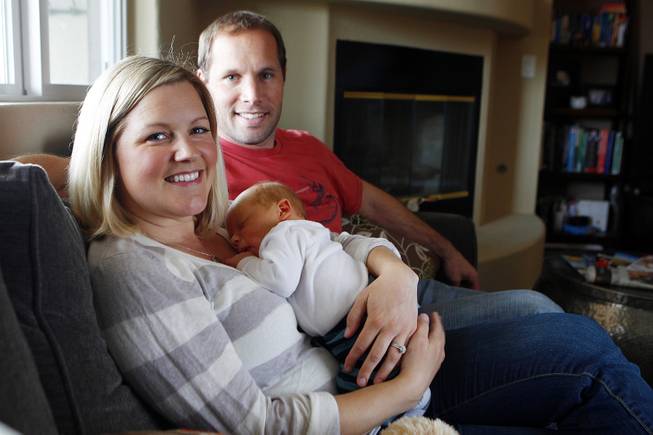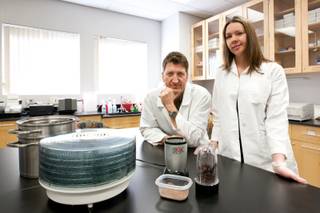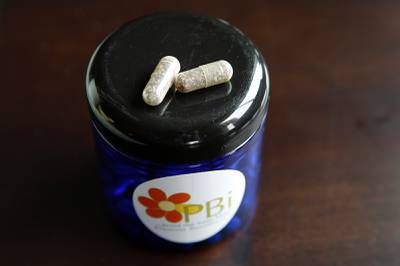
Sam Morris / Las Vegas Sun
Lisa and Brent Stark sit with their newborn Will Thursday, Feb. 21, 2013. Lisa had Will’s placenta dried and turned into pill form for her to take to avoid postpartum depression.
Friday, March 1, 2013 | 2 a.m.
When Lisa Stark gave birth to her second son in January, she decided to save her placenta.
In most cases, this organ that nourishes the fetus is discarded after childbirth. In some cultures, the placenta is considered sacred and is buried under a tree.
Stark had something else in mind for her placenta. She wanted to eat it.
Just hours after giving birth, Stark invited a placenta encapsulation specialist into her Anthem home. Over the span of two days, Stark's placenta was cooked and dried into jerky-like strips, then ground into cumin-like powder and finally packed into more than 100 gelatin capsules.
Stark says taking these 500-milligram placenta pills two times a day has helped her ward off the baby blues. But exchanging prenatal vitamins for postpartum placenta pills has raised more than a few eyebrows.
"Everyone's initial reaction was 'yuck,'" Stark, 34, said. "My mom was pretty grossed out by it. People are now more supportive, but plenty of my friends and family think it's still crazy."
•••
Placentophagia, the practice of consuming placenta, has a small but growing number of advocates across the United States. The trend started during the late 1970s, coinciding with the rise of the home-birth movement.
Proponents contend new mothers can prevent postpartum depression, boost energy and increase milk production by ingesting their placenta. They say it's a natural remedy; most land mammals — camels, marsupials and humans are among the noted exceptions — eat their afterbirth.
Jodi Selander, who converted Stark's placenta into pills, is a staunch believer in the power of the placenta. In fact, the North Las Vegas mother gave birth to the placentophagy movement among mainstream mothers in the United States.
After delivering her first daughter 10 years ago, Selander suffered from a severe case of the baby blues. She was tired all the time and just felt overwhelmed.
Postpartum depression occurs when new mothers experience symptoms of withdrawal after the high level of pregnancy hormones suddenly disappear after childbirth.
"No one tells you this, but becoming a mother is really hard," Selander said. "You're put up on this pedestal and expected to be this perfect mother. But you can't stop crying and you feel like such a failure."
After her brush with the baby blues, Selander consulted with an acupuncturist trained in Chinese traditional medicine. The acupuncturist told her that, centuries ago, Chinese men and women consumed placenta to improve their mood and energy.
Selander became fascinated with the idea that the fruit of her labor could perhaps be the cure to her baby blues.
•••
The ancient Chinese practice of 'zi he che,' or dried human placenta medicine, calls for the afterbirth to be steam-cooked, dehydrated and ground into powder. By encapsulating the powder into pills, Selander found the idea of consuming her own placenta became more palatable.
In 2005, after the birth of her second daughter, Selander went on the placenta pills.
"The difference was amazing," Selander, 36, said. "I was calm, serene and didn't lose my patience. I felt so good, and I had a lot of energy."
Buoyed by her discovery, the former computer programmer launched her online afterbirth business PlacentaBenefits.info in 2006.
Selander standardized the process of placenta encapsulation — ensuring that it met federal sanitation guidelines — and began selling do-it-yourself home kits and instructional pamphlets to women around the world.
Selander also began preparing placenta pills for local mothers, charging $250 per encapsulation. At first, Selander was encapsulating one placenta every two months. But demand grew to the point where Selander and her assistants encapsulate 20 placentas a month. Selander estimates she has encapsulated more than 500 placentas so far.
As placentophagy became more popular, Selander started a certification program for people interested in encapsulating placenta for new mothers. Currently, Selander has more than 300 certified placenta specialists and another 200 specialists-in-training in her global network.
•••
Across town, a team of UNLV researchers is poring over a thawing hunk of placenta inside a white-walled laboratory dotted with orange biohazard warning stickers.
Moments ago, the frozen specimen was taken out of a special freezer that holds a dozen more donated placenta samples at a constant minus 40 degrees Fahrenheit. Atop a nearby table sits a steel pot, dehydrators and a Magic Bullet blender used in placenta encapsulation.
It's in this room that medical anthropologist Daniel Benyshek and doctoral student Sharon Young are pioneering the research on human placentophagy.
Over the past two decades, researchers have published limited studies on animal placentophagy. However, the research on human placentophagy is uncharted territory. Benyshek and Young, who have been studying placentas since 2008, are hoping to lead the nation in this emerging field of study.
On Wednesday, Benyshek and Young published the first study of human placentophagy, which looked at women's motivations and experience with ingesting placenta.
UNLV's survey of nearly 200 women around the world found that most respondents who consumed placenta did it to improve their mood and energy.
The women in the study were overwhelmingly American, white, married, college-educated and solidly middle- to upper-middle class. Most of the women had home births.
An overwhelming majority found it to be a positive experience. Nearly everyone said they would try it again.
•••
Stark didn't need the UNLV study to tell her what she already knew.
Before she started taking her placenta pills, Stark said she was short-tempered and anxious. Small disturbances or tasks, such as trying to find a missing object, had a tendency to set her off.
"I lost it," Stark said. "Emotionally, I couldn't deal with what was happening. I was mad at my toddler and husband, and I felt completely overwhelmed."
Postpartum depression is often underdiagnosed in new mothers, and it could take weeks for a woman's body to readjust to her pre-pregnancy hormone levels, Selander said. That gap leaves many new mothers in the lurch.
The placenta pills — while unfounded scientifically — are fast becoming the natural alternative to chemical antidepressants. In fact, many husbands are some of the strongest proponents of maternal placentophagy, Selander said.
The Starks first heard about the placenta pills two years ago at a birthing class. Stark's husband, Brent, quickly latched on to the idea. The commercial airline pilot wasn't certain of the science behind it, but saw firsthand the difference it made.
"I felt blissed out," Lisa Stark said. "I felt calm and happy, and all of that anxiety was gone."
But what about the taste?
"It's not like you're chewing it," Stark said, smiling. "It's more like you're swallowing it. You don't taste much of anything."




Join the Discussion:
Check this out for a full explanation of our conversion to the LiveFyre commenting system and instructions on how to sign up for an account.
Full comments policy